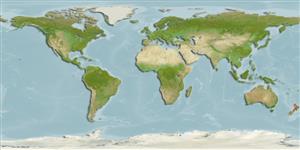>
Blenniiformes (Blennies) >
Tripterygiidae (Triplefin blennies) > Tripterygiinae
Etymology: Karalepis: Greek, kara = face + Greek, lepis = scale (Ref. 45335); stewarti: Named after A.L. Stewart of the NMNZ, Department of Fishes, collector of the holotype of this species.
Eponymy: Andrew Louis Stewart (d: 1958) is Collection Manager: Science (Fishes) at the Museum of New Zealand Te Papa Tongerewa. [...] (Ref. 128868), visit book page.
Environment: milieu / climate zone / depth range / distribution range
Ecologie
marien demersaal; diepte 0 - 33 m (Ref. 13227), usually 0 - 10 m (Ref. 13227). Temperate
Southwest Pacific: around mainland New Zealand.
Grootte / Gewicht / Leeftijd
Maturity: Lm ? range ? - ? cm
Max length : 15.0 cm TL mannelijk / geslacht onbekend; (Ref. 9003)
Nocturnal species found in crevices or holes during the day. Adults feed on small crustaceans and mollusks (Ref. 13227). Eggs are hemispherical and covered with numerous sticky threads that anchor them in the algae on the nesting sites (Ref. 240). Larvae are planktonic which occur primarily in shallow, nearshore waters (Ref. 94114).
Levenscyclus en paargedrag
Maturiteit | Voortplanting | Paaien | Eieren | Fecunditeit | Larven
Fricke, R., 1994. Tripterygiid fishes of Australia, New Zealand and the southwest Pacific Ocean (Teleostei). Theses Zool. 24:1-585. (Ref. 13227)
Status op de Rode Lijst van het IUCN (Ref. 130435: Version 2024-1)
Gevaar voor de mens
Harmless
Gebruik door de mens
Visserij: van geen belang
Tools
Speciale rapporten
Download XML
Internetbronnen
Estimates based on models
Preferred temperature (Ref.
123201): 10.6 - 21.2, mean 15.9 °C (based on 182 cells).
Fylogenetische diversiteitsindex (Ref.
82804): PD
50 = 1.0000 [Uniqueness, from 0.5 = low to 2.0 = high].
Bayesian length-weight: a=0.00692 (0.00360 - 0.01331), b=3.07 (2.90 - 3.24), in cm total length, based on LWR estimates for this species & (Sub)family-body (Ref.
93245).
Trofisch niveau (Ref.
69278): 3.3 ±0.40 se; based on food items.
Generation time: 2.0 ( na - na) years. Estimated as median ln(3)/K based on 1
growth studies.
Weerstandsvermogen (Ref.
120179): Hoog, minimale populatieverdubbelingstijd minder dan 15 maanden (K=0.54).
Fishing Vulnerability (Ref.
59153): Low vulnerability (10 of 100).
Nutrients (Ref.
124155): Calcium = 80.9 [49.0, 172.9] mg/100g; Iron = 0.477 [0.302, 0.830] mg/100g; Protein = 18.4 [17.5, 19.3] %; Omega3 = 0.643 [0.366, 1.176] g/100g; Selenium = 8.25 [4.20, 16.78] μg/100g; VitaminA = 22.5 [6.4, 76.3] μg/100g; Zinc = 0.813 [0.571, 1.154] mg/100g (wet weight);
